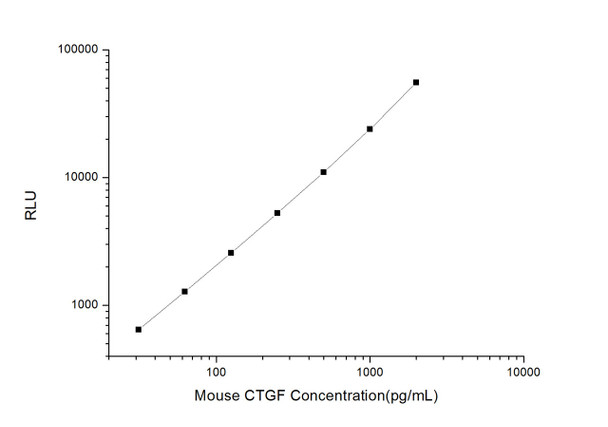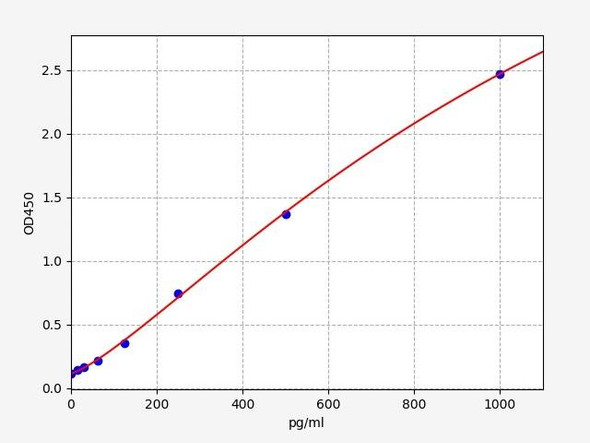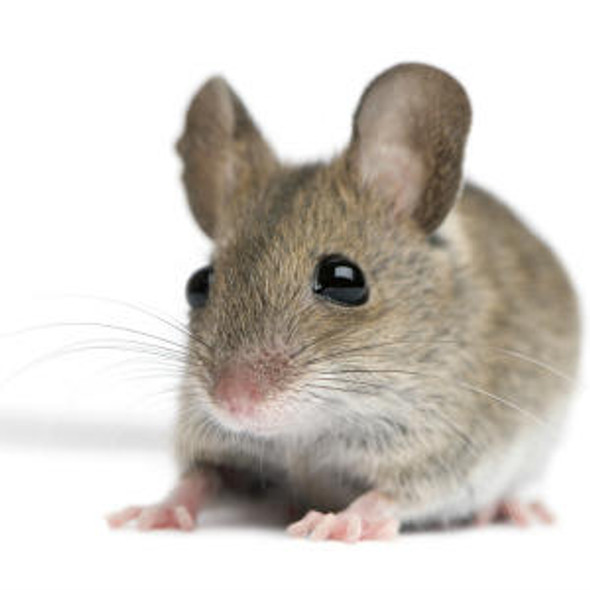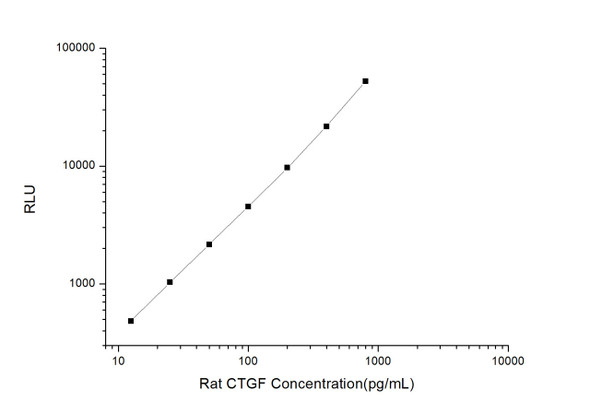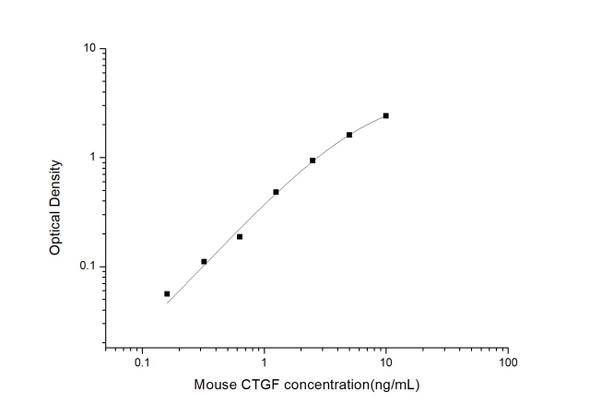Mouse Cell Biology ELISA Kits 2
Mouse CTGF (Connective Tissue Growth Factor) CLIA Kit (MOES00195)
- SKU:
- MOES00195
- Product Type:
- ELISA Kit
- ELISA Type:
- CLIA Kit
- Size:
- 96 Assays
- Sensitivity:
- 18.75pg/mL
- Range:
- 31.25-2000pg/mL
- ELISA Type:
- Sandwich
- Synonyms:
- CCN2, HCS24, IGFBP8, NOV2
- Reactivity:
- Mouse
- Sample Type:
- Serum, plasma and other biological fluids
- Research Area:
- Cell Biology
Description
| Assay type: | Sandwich |
| Format: | 96T |
| Assay time: | 4.5h |
| Reactivity: | Mouse |
| Detection method: | Chemiluminescence |
| Detection range: | 31.25-2000 pg/mL |
| Sensitivity: | 18.75 pg/mL |
| Sample volume: | 100µL |
| Sample type: | Serum, plasma and other biological fluids |
| Repeatability: | CV < 15% |
| Specificity: | This kit recognizes Mouse CTGF in samples. No significant cross-reactivity or interference between Mouse CTGF and analogues was observed. |
This kit uses Sandwich-CLIA as the method. The micro CLIA plate provided in this kit has been pre-coated with an antibody specific to Mouse CTGF. Standards or samples are added to the appropriate micro CLIA plate wells and combined with the specific antibody. Then a biotinylated detection antibody specific for Mouse CTGF and Avidin-Horseradish Peroxidase (HRP) conjugate are added to each micro plate well successively and incubated. Free components are washed away. The substrate solution is added to each well. Only those wells that contain Mouse CTGF, biotinylated detection antibody and Avidin-HRP conjugate will appear fluorescence. The Relative light unit (RLU) value is measured spectrophotometrically by the Chemiluminescence immunoassay analyzer. The RLU value is positively associated with the concentration of Mouse CTGF. The concentration of Mouse CTGF in the samples can be calculated by comparing the RLU of the samples to the standard curve.
| UniProt Protein Function: | CTGF: Major connective tissue mitoattractant secreted by vascular endothelial cells. Promotes proliferation and differentiation of chondrocytes. Mediates heparin- and divalent cation-dependent cell adhesion in many cell types including fibroblasts, myofibroblasts, endothelial and epithelial cells. Enhances fibroblast growth factor-induced DNA synthesis. Belongs to the CCN family. 2 isoforms of the human protein are produced by alternative splicing. |
| UniProt Protein Details: | Protein type:Secreted, signal peptide; Secreted; Cell adhesion Cellular Component: cell cortex; cis-Golgi network; cytosol; extracellular region; extracellular space; Golgi apparatus; intracellular membrane-bound organelle; perinuclear region of cytoplasm; proteinaceous extracellular matrix Molecular Function:fibronectin binding; growth factor activity; heparin binding; insulin-like growth factor binding; integrin binding; protein C-terminus binding Biological Process: angiogenesis; cartilage condensation; cell adhesion; cell differentiation; cell migration; cell-cell signaling; cell-matrix adhesion; fibroblast growth factor receptor signaling pathway; integrin-mediated signaling pathway; lung development; ossification; positive regulation of caspase activity; positive regulation of cell activation; positive regulation of cell differentiation; positive regulation of cell proliferation; positive regulation of collagen biosynthetic process; positive regulation of JNK cascade; positive regulation of protein amino acid phosphorylation; positive regulation of stress fiber formation; regulation of cell growth; regulation of chondrocyte differentiation; tissue homeostasis |
| UniProt Code: | P29268 |
| NCBI GenInfo Identifier: | 171846283 |
| NCBI Gene ID: | 14219 |
| NCBI Accession: | NP_034347. 2 |
| UniProt Secondary Accession: | P29268,Q922U0, G5E830, |
| UniProt Related Accession: | P29268 |
| Molecular Weight: | 53. 5 kDa |
| NCBI Full Name: | connective tissue growth factor |
| NCBI Synonym Full Names: | connective tissue growth factor |
| NCBI Official Symbol: | Ctgf |
| NCBI Official Synonym Symbols: | Ccn2; Hcs24; Fisp12; fisp-12 |
| NCBI Protein Information: | connective tissue growth factor |
| UniProt Protein Name: | Connective tissue growth factor |
| UniProt Synonym Protein Names: | CCN family member 2; Hypertrophic chondrocyte-specific protein 24; Protein FISP-12 |
| Protein Family: | Connective tissue growth factor |
| UniProt Gene Name: | Ctgf |
| UniProt Entry Name: | CTGF_MOUSE |
As the RLU values of the standard curve may vary according to the conditions of the actual assay performance (e. g. operator, pipetting technique, washing technique or temperature effects), the operator should establish a standard curve for each test. Typical standard curve and data is provided below for reference only.
| Concentration (pg/mL) | RLU | Average | Corrected |
| 2000 | 54378 57064 | 55721 | 55693 |
| 1000 | 23668 24280 | 23974 | 23946 |
| 500 | 11068 10996 | 11032 | 11004 |
| 250 | 4918 5670 | 5294 | 5266 |
| 125 | 2795 2421 | 2608 | 2580 |
| 62.5 | 1408 1214 | 1311 | 1283 |
| 31.25 | 629 719 | 674 | 646 |
| 0 | 27 29 | 28 | -- |
Precision
Intra-assay Precision (Precision within an assay): 3 samples with low, mid range and high level Mouse CTGF were tested 20 times on one plate, respectively.
Inter-assay Precision (Precision between assays): 3 samples with low, mid range and high level Mouse CTGF were tested on 3 different plates, 20 replicates in each plate.
| Intra-assay Precision | Inter-assay Precision | |||||
| Sample | 1 | 2 | 3 | 1 | 2 | 3 |
| n | 20 | 20 | 20 | 20 | 20 | 20 |
| Mean (pg/mL) | 99.13 | 316.59 | 841.86 | 100.52 | 310.84 | 821.86 |
| Standard deviation | 12.01 | 22.64 | 92.27 | 9.85 | 28.60 | 51.28 |
| C V (%) | 12.12 | 7.15 | 10.96 | 9.80 | 9.20 | 6.24 |
Recovery
The recovery of Mouse CTGF spiked at three different levels in samples throughout the range of the assay was evaluated in various matrices.
| Sample Type | Range (%) | Average Recovery (%) |
| Serum (n=5) | 96-110 | 104 |
| EDTA plasma (n=5) | 86-100 | 93 |
| Cell culture media (n=5) | 87-101 | 93 |
Linearity
Samples were spiked with high concentrations of Mouse CTGF and diluted with Reference Standard & Sample Diluent to produce samples with values within the range of the assay.
| Serum (n=5) | EDTA plasma (n=5) | Cell culture media (n=5) | ||
| 1:2 | Range (%) | 101-115 | 97-110 | 99-112 |
| Average (%) | 107 | 104 | 104 | |
| 1:4 | Range (%) | 91-102 | 102-118 | 98-112 |
| Average (%) | 97 | 109 | 104 | |
| 1:8 | Range (%) | 95-108 | 100-117 | 93-105 |
| Average (%) | 101 | 107 | 98 | |
| 1:16 | Range (%) | 99-114 | 86-101 | 86-100 |
| Average (%) | 106 | 93 | 92 |
An unopened kit can be stored at 4°C for 1 month. If the kit is not used within 1 month, store the items separately according to the following conditions once the kit is received.
| Item | Specifications | Storage |
| Micro CLIA Plate(Dismountable) | 8 wells ×12 strips | -20°C, 6 months |
| Reference Standard | 2 vials | |
| Concentrated Biotinylated Detection Ab (100×) | 1 vial, 120 µL | |
| Concentrated HRP Conjugate (100×) | 1 vial, 120 µL | -20°C(shading light), 6 months |
| Reference Standard & Sample Diluent | 1 vial, 20 mL | 4°C, 6 months |
| Biotinylated Detection Ab Diluent | 1 vial, 14 mL | |
| HRP Conjugate Diluent | 1 vial, 14 mL | |
| Concentrated Wash Buffer (25×) | 1 vial, 30 mL | |
| Substrate Reagent A | 1 vial, 5 mL | 4°C (shading light) |
| Substrate Reagent B | 1 vial, 5 mL | 4°C (shading light) |
| Plate Sealer | 5 pieces | |
| Product Description | 1 copy | |
| Certificate of Analysis | 1 copy |
- Set standard, test sample and control (zero) wells on the pre-coated plate and record theirpositions. It is recommended to measure each standard and sample in duplicate. Note: addall solutions to the bottom of the plate wells while avoiding contact with the well walls. Ensuresolutions do not foam when adding to the wells.
- Aliquot 100 µL of standard solutions into the standard wells.
- Add 100 µL of Sample / Standard dilution buffer into the control (zero) well.
- Add 100 µL of properly diluted sample (serum, plasma, tissue homogenates and otherbiological fluids. ) into test sample wells.
- Cover the plate with the sealer provided in the kit and incubate for 90 min at 37 °C.
- Aspirate the liquid from each well, do not wash. Immediately add 100 µL of BiotinylatedDetection Ab working solution to each well. Cover the plate with a plate seal and gently mix. Incubate for 1 hour at 37 °C.
- Aspirate or decant the solution from the plate and add 350 µL of wash buffer to each welland incubate for 1-2 minutes at room temperature. Aspirate the solution from each well andclap the plate on absorbent filter paper to dry. Repeat this process 3 times. Note: a microplatewasher can be used in this step and other wash steps.
- Add 100 µL of HRP Conjugate working solution to each well. Cover with a plate seal andincubate for 30 min at 37 °C.
- Aspirate or decant the solution from each well. Repeat the wash process for five times asconducted in step 7.
- Add 100 µL of Substrate mixture solution to each well. Cover with a new plate seal andincubate for no more than 5 min at 37 °C. Protect the plate from light.
- Determine the RLU value of each well immediately.

